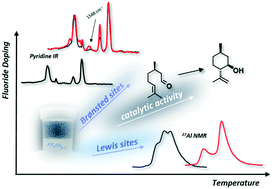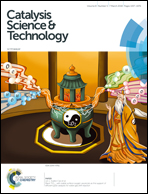A novel fluoride-doped aluminium oxide catalyst with tunable Brønsted and Lewis acidity
Abstract
The fluorination of transition aluminas has long been used to modify their properties and tune their catalytic performance. In this study, the preparation of a novel F-doped Al2O3 catalyst is demonstrated. The introduced two-step synthesis route enabled adjustment of the amount of fluoride and thus control of the characteristic properties of the catalyst. Structural investigation by XRD, 19F and 27Al MAS NMR revealed the formation of an F-doped Al2O3 phase at high temperatures (700 °C). This new phase shows high similarity to common transition aluminium oxides like γ-Al2O3. Contrary to other fluorinated alumina, in this phase fluoride is finely distributed throughout the bulk and surface of the sample. Surface characterisation methods like nitrogen and pyridine adsorption and NH3-TPD revealed a vital influence of fluoride doping for catalytic purposes. This is evidenced by the increased acidic strength and the introduction of strong Brønsted acid sites. Different from other systems, these Brønsted acid sites are formed despite the absence of a proton-rich atmosphere. The high catalytic potential of this new F-doped Al2O3 is additionally demonstrated in a catalytic test reaction which is the cyclisation of citronellal to isopulegol, a key step in the synthetic production of menthol.



 Please wait while we load your content...
Please wait while we load your content...